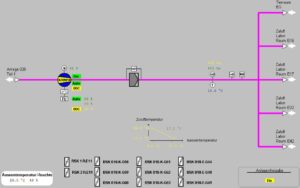Virtual energy data system
In this post I will explain an idea to convert a building management system (BMS) into a virtual energy data system that will guide us when it comes to knowing what our consumption is. The problem lies in the fact that the BMS gives partial information and does not include energy information, so we will have to carry out a conversion. The starting point is a BMS that gives us information about internal measurement points and control parameters.

In the following picture we see the representation of an air conditioning system that supplies a few laboratories. We can see a fan that feeds a distributor of 4 laboratories. We have information on the panel but is not complete. We only have the percentage of opening of the fan. For our energy management system it would be much more convenient to have in addition to the electrical consumption of this equipment and the air flow that it supplies.

This problem occurs often since the BMS has not been designed to give this additional functionality. It has been conceived to control and maintain the building but maybe not in an efficient way. Sometimes the different company’s information management systems are independent of each other and incompatibles.
For instance, in this example the energy data collection system is quite limited and we have a very small number of electricity and gas meters. Let’s say we only have the counters for the total consumption of the building. And we would like to have more information to be able to find potentials and then carry out saving actions. We could admit that the additional information we need is not fully accurate and that an approximation would be useful. If we knew the estimated consumption from the fan in the picture or from all of the elements of the building we could compare it with the total electric consumption.
Well, a useful way to do this approximation is to determine the consumption and physical properties of the elements. That is, we could carry out a measurement campaign on the fan and the rest of the modules. In this period of time we need multiple working points. So we could draw a characteristic curve of the component in an approximate way. We will try to obtain a parallel scale to the capacity scale of the of the element, which gives us the value of the properties that we want to know.
We calibrate the instrument with amperometric clamps (consumption) throughout its work cycle and also check the physical parameters of the air it moves (air flow). During all this time we also record what the values of that component in the BMS.
We have just a tool that will translate the variable in the BMS into energy and phisycal properties, which is more useful for our future energy projects.
So we have done a calibration of that element. Now, by means of these standardization we are able to know an estimate of other properties through the BMS parameter. We have a formula which converts the values from BMS into other properties.
If we repeat this process with all the equipments we can monitor the total consumption over time. With this information we can determine potentials according to the consumption patterns we may detect. Or we can check the effect of a saving project.

Finally, we could include the new information that comes from the measurement campaign in the BMS. We are now in the position to start with the search for savings potential and the implementation of projects.
